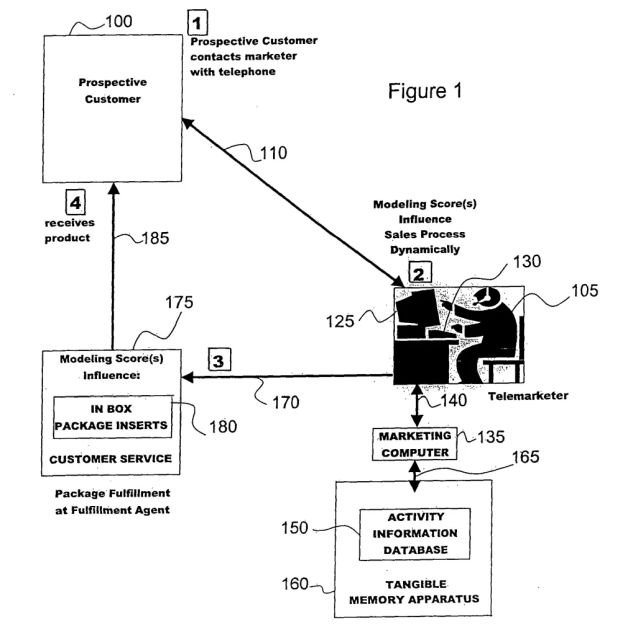This EPO Board of Appeal decision concerns a patent application for an automatic selection of a marketing script. In the appeal, the Board noted that considerations were all non-technical business concepts. Therefore, although computers were technical, the implementation of the non-technical requirements would have been obvious to the skilled person in the art of telecommunication and computer systems.
This decision is one of the good examples of how the COMVIK approach is applied and how the technical implementation of the non-technical requirements are assessed for inventive step. Here are the practical takeaways from the decision T 1141/17 (Automatic selection of a marketing script/FRASER) of 15.4.2021, of Technical Board of Appeal 3.5.01:
Key takeaways
Identifying a customer contacting a business, selecting a marketing script from a plurality of customer value segments based on the customer's "modelling score", and presenting the selected script to the marketer are all non-technical business concepts.
Technical implementation of the non-technical requirements, including identifying the customer (caller) and the contacted business (callee), use of the computer to look up information in a database, calculate the modelling score, and select and display a relevant script, would have been obvious to the skilled person in the art of telecommunications and computer systems
Computers are technical, but it would have been obvious to use one for selecting a script in accordance with the requirement specification.
The invention
The European patent application relates a method and apparatus for providing marketing intelligence about prospective customers to sales representatives utilizing telecommunication equipment.
When a potential customer calls a number on a tele-advertisement, the call is often received by a sales representative that represents many businesses. The sales representative needs to find the marketing script associated with the product or service the customer is calling about. Furthermore, it is advantageous to use a script that is targeted to the prospective customer, for example, a high-value client may receive different offers than a low-value purchase.
The invention identifies the dialled number (DNIS) associated with the product or service in the advertisement and uses the Caller I.D (ANI) to identify the calling customer. This information is used to calculate a "modelling score" of the customers' value, and the salesperson is presented with the script depending on the score and time of the call (depending on when the advertisement is on the local cable network of a region).

Fig. 1 of WO 2005/122041 A2
Here is how the invention was defined in claim 1 of the main request of EP App no. 05753764.9 :
Claim 1
A computer system for linking a marketer to customers comprising:
- a customer communications device utilized by a prospective customer, connected to a first communications link and which initiates a customer communication having an Automatic Number Identification (ANI) unique identification number of the customer communications device and a unique Dialed Number Identification Service (DNIS) linking number identification and sends the customer communication to the first communications link;
- a marketer communications device utilized by a marketer connected to the first communications link and which receives the customer communication and the ANI unique identification number and the unique DNIS linking number identification from the customer communications device;
- a computer operated by the marketer connected to the marketer communications device via a second communications link and which receives the ANI unique identification number and the unique DNIS linking number identification from the marketer communications device;
- a tangible memory apparatus operably connected to the computer via a communications channel and having a database containing customer information associated with ANI unique identification numbers and a plurality of scripts to be used by the marketer in communicating with the prospective customer, the scripts divided into a plurality of customer value segments, being high, medium, low or risk or a combination thereof;
wherein said computer:
uses the ANI unique identification number of the customer communication device to locate customer information of the prospective customer from the database and calculate a modeling score of the prospective customer based upon the customer information of the prospective customer and the unique DNIS dialed number identification;
selects a script, based on the modeling score of the prospective customer, from the tangible memory apparatus contemporaneously with a time at which the customer communications device provides the ANI unique identification number; and
displays the script to the marketer, to be used by the marketer to communicate with the prospective customer, prior to any communication with the prospective customer.
Is it patentable?
In the first instance, the Examination Division considered that the claimed invention lacked an inventive step over a conventional system combining telephony and computer processing technologies as exemplified by document D1 (US6597685 B), as the distinguishing features were found to provide obvious automation of a set of administrative, i.e. non-technical, steps.
The Board tended to agree with the assessment and summarised the invention as a classic mixed-type invention, where the COMVIK approach had to be applied:
2.1 The invention in claim 1 comprises a mixture of technical and non-technical features. The Board agrees with the appellant that the claimed computer system and its components have technical character. However, the invention also involves non-technical aspects related to marketing.
2.2 The established approach for assessing such mixed-type inventions is the "Comvik approach" (see T 641/00 - Two identities/COMVIK, and The Case Law of the Boards of Appeal, 9th edition, 9.1.3 b)). Under the Comvik approach, only the technical features which contribute to the solution of a technical problem by providing a technical effect are taken into account for the purpose of assessing inventive step under Article 56 EPC. The non-technical features which make no technical contribution may legitimately form part of the technical problem to be solved as a set of requirements to be met.
The Board then went on to identify the non-technical business concepts and the distinguishing features over the conventional system:
2.3 Applying the Comvik approach to the present case, the Board considers that the following included in or underlying claim 1 is part of a non-technical business concept:
- A customer, having an identity contacting a business (also having an identity) about a product or service;
- A marketer dealing with the customer on behalf of the business;
- Selecting a marketing script from a plurality of marketing scripts divided into a plurality of customer value segments (high, medium, low or "risk" or a combination thereof) based on the customer's "modelling score" and the relevant business, product or service;
- presenting the selected script to the marketer.
Being non-technical in nature, the above features cannot contribute to inventive step. Instead, they form a set of requirements which are part of the problem to be solved.
2.4 Starting from a conventional communication system combining a telephone system and a computer system, such as the one disclosed in D1, the invention in claim 1 distinguishes itself by the use of the ANI to locate customer information in a database, the calculation of a modeling score based upon the customer information and the DNIS, the selection of a stored script based on the modeling score contemporaneously with a time at which the customer communications device provides the ANI, and the display of the script to the marketer.
2.5 In line with the Comvik approach, the Board considers that the problem to be solved by the distinguishing features is how to automate the method of selecting a customised script defined under point 2.3 above.
Finally, the Board then noted that the implementation of the non-technical requirement was obvious to a skilled person:
2.6 In the Board's view, the technical implementation of the non-technical requirements, including the use of ANI and DNIS to identify the customer (caller) and the contacted business (callee) respectively, and the use of the computer to contemporaneously look up information in a database, calculate the modelling score, and select and display a relevant script, would have been obvious to the skilled person in the art of telecommunications and computer systems. ANI and DNIS were well known and designed to provide the recipient of the telephone call with information about the caller and the dialled number. The skilled person would have provided suitable means for storing and retrieving data, including the use of the ANI as an identifier for storing and retrieving customer information in a database.
3. The appellant argued that, while known, the ANI and DNIS numbers had never been used for looking up customer information in a database and for calculating a modelling score for selecting a script. The use of the ANI and DNIS in this way enabled selection of the script contemporaneously, which really meant less than 7/10th of a second. The invention thus achieved a low response time, which was a technical effect that contributed to inventive step in a non-obvious manner.
4. In the Board's assessment, however, the low response time is an effect of the automation, i.e. the use of a computer to select a script. Computers are technical, but the Board judges that it would have been obvious to use one for selecting a script in accordance with the requirement specification. The Board notes that neither the claim, nor the application as a whole, specifies any particular technical implementation details which could support a low response time beyond that achieved by merely using a computer.
Therefore, the Board decided that the subject-matter of claim 1 lacked an inventive step. Therefore, the appeal of the applicant was dismissed.
You can read the whole decision here: T 1141/17 (Automatic selection of a marketing script/FRASER) of 15.4.2021.
The content of this article is intended to provide a general guide to the subject matter. Specialist advice should be sought about your specific circumstances.


